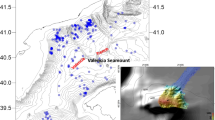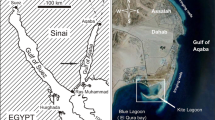Abstract
The distribution and ecology of the Ampelisca ledoyeri population at the hydrothermal field off Panarea Island, Aeolian Archipelago (NE Sicily), were investigated during four cruises in June and November 2010, and June 2011, 2013. Extensive patches of emerging tubes were observed during ROV dives and subsequently grab sampled. The tubes were inhabited by the amphipod A. ledoyeri and were located close to the hydrothermal structures, with average densities ranging from 14.5 to 108.9 tubes/m2. A. ledoyeri dominated the benthic community in terms of abundance (44.4 %), monopolizing the thin layer of fine sediment covering a Fe-rich crustose substratum from 80 to 120 m depth. The evidenced bathymetric gradient, with decreasing numbers of individuals from 80–85 m (184 ± 266.01 individuals) to 120 m (6.95 ± 16.08 individuals), respectively, corresponded to Fe-rich sediments due to geothermal lower energy and higher energy hydrothermal crusts and chimneys. The gut contents of A. ledoyeri, consisting of a fine, rusty matter similar to the seep-surface deposits, suggested that such a deposit feeder might play a key role in the hydrothermal food web, both in terms of secondary production and “detrital” organic matter stored in the sediment as mucus tubes.




Similar content being viewed by others
References
Anderson MJ, Gorley RN, Clarke KR (2008) PERMANOVA + for PRIMER: guide to software and statistical methods. PRIMER-E, Plymouth
Anzidei M, Esposito A, Bortoluzzi G, De Giosa F (2005) The high resolution bathymetric map of the exhalative area of Panarea (Aeolian Islands, Italy). Ann Geophys 48(6):899–921
Aslan-Cihangir H, Pancucci-Papadopoulou MA (2011) Spatial and temporal variation of soft-bottom peracarid (Crustacea: Peracarida) infauna in the Canakkale Strait (Turkey). Medit Mar Sci 12(1):153–182
Barnard JL (1960) New bathyal and sublittoral ampeliscid amphipods from California, with an illustrated key to Ampelisca. Pac Nat 1(16):1–36
Barnard JL (1969) The families and genera of marine gammaridean Amphipoda. U S Nat Mus Bull 271:1–535
Barnard JL, Karaman G (1991) The families and genera of marine gammaridean Amphipoda (except marine gammaroids). Rec Aust Mus 13(supplements 1 and 2):1–866
Bellan-Santini D, Dauvin JC (1988) Elements de synthèse sur les Ampelisca du nord-est Atlantique. Crustaceana Suppl 13:20–60
Bellan-Santini D, Dauvin JC (1989) Distribution verticale et répartition biogéographique de Crustacés holobenthiques filtreurs: exemple des Amphipodes du genre Ampelisca, groupe zoologique à forte spéciation. Bull Soc Geol Fr 5:561–568
Bellan-Santini D, Thurston MH (1996) Amphipoda of the hydrothermal vents along the mid-Atlantic Ridge. J Nat Hist 30:685–702
Buchanan JB, Kain JM (1971) Measurement of the physical and chemical environment. In: Holmes NA, MacIntyre AD (eds) Methods for the study of Marine Benthos. Blackwell Scientific Publications, Oxford, p 387
Caracausi A, Ditta M, Italiano F, Longo M, Nuccio PM, Paonita A (2005) Massive submarine gas output during the volcanic unrest off Panarea Island (Aeolian Arc, Italy): interferences for explosive conditions. Geochem J 39:459–467
Clarke KR, Warwick RM (2001) Change in marine communities: an approach to statistical analysis and interpretation, 2nd edn. PRIMER-E, Plymouth
Cordes EE, Hourdez S, Predmore BL, Redding ML, Fisher CR (2005) Succession of hydrocarbon seep communities associated with the long-lived foundation species Lamellibrachia luymesi. Mar Ecol Prog Ser 305:17–29
Dauvin JC, Bellan-Santini D (1988) Illustrated key to Ampelisca species from the north-eastern Atlantic. J Mar Biol Assoc UK 68:659–676
Dauvin JC, Bellan-Santini D (1996) Ampeliscidae (Amphipoda) from the bay of Biscay. J Crustac Biol 16(1):149–168
Dauvin JC, Alizier S, Weppe A, Guðmundsson G (2012) Diversity and zoogeography of Icelandic deep-sea Ampeliscidae (Crustacea: Amphipoda). Deep-Sea Res I 68:12–23
De Biasi AM, Aliani S (2003) Shallow-water hydrothermal vents in the Mediterranean sea: stepping stones for Lessepsian migration? Hydrobiologia 503:37–44
Decembrini F, Caroppo C, Azzaro A (2009) Size structure and production of phytoplankton community and carbon pathways channelling in the Southern Tyrrhenian Sea (Western Mediterranean). Deep-Sea Res II 56:687–699
Dekov VM, Kamenov GD, Abrasheva MD, Capaccioni B, Munnik F (2013) Mineralogical and geochemical investigation of seafloor massive sulfides from Panarea Platform (Aeolian Arc, Tyrrhenian Sea). Chem Geol 335:136–148
Diaz RJ, Rhoads DC, Blake JA, Kropp RK, Keay KE (2008) Long-term trends of benthic habitats related to reduction in wastewater discharge to Boston harbor. Estuar Coasts 31:1184–1197
Dickinson JJ (1982) The systematic and distributional ecology of the family Ampeliscidae (Amphipoda: Gammaridea) in the northeastern Pacific region, I. The genus Ampelisca. Nat Mus Nat Sci (Ottawa) Publ Biol Oceanogr 10:1–39
Dickinson JJ (1983) The systematic and distributional ecology of the superfamily Ampeliscoidea (Amphipoda: Gammaridea) in the northeastern Pacific Region, II. The genera Byblis and Haploops. Nat Mus Nat Sci (Ottawa) Publ Biol Oceanogr 1:1–38
Gamberi F, Marani M, Savelli C (1997) Tectonic, volcanic and hydrothermal features of a submarine portion of the Aeolian arc (Tyrrhenian Sea). Mar Geol 140:167–181
Gamberi F, Marani M, Parr JM, Binns RA (1999) Sub-seafloor mineralisation at the Panarea shallow-water platform, Aeolian volcanic arc, Italy. In: Stanley CJ et al (eds) Mineral deposits, processes to processing. Balkema, Rotterdam, pp 499–502
Grebmeier JM, McRoy CP (1989) Pelagic-benthic coupling on the shelf of the northern Bering and Chukchi Seas. 111. Benthic food supply and carbon cycling. Mar Ecol Prog Ser 53:79–91
Gugliandolo C, Italiano F, Maugeri T (2006) The submarine hydrothermal system of Panarea (Southern Italy): biogeochemical processes at the thermal fluids-sea bottom interface. Ann Geophys 49(2/3):783–792
Hanert HH (1981) Bakterielle und chemische Eisen(II)-oxidation auf Palaea Kameni-stereoscan, elektronenestrahl-mikroanalyse (FeKa) und photometrie von in situ-experimenten. In: Puchelt ESH (ed) Genesis of marine iron sediments from Santorini, Greece. Springer, Berlin
Kamenev GM, Fadeev VI, Selin NI, Tarasov VG (1993) Composition and distribution of macro- and meiobenthos around sublittoral hydrothermal vents in the Bay of Plenty, New Zealand. N Z J Mar Freshw Res 27:407–418
King RA (2009) Ampeliscidae. Zootaxa 2260:132–142
Laughlin JD (1981) Gut analysis of polychaetes and amphipods. Coastal Water Research Project Annual Report for the Year Ended, 59
Marani M, Gamberi F, Savelli C (1997) Shallow-water polymetallic sulphide deposits in the Aeolian island arc. Geology 25(9):815–818
Martin JW, France SC, Van Dover CL (1993) Halice hesmonectes, a new species of pardaliscid amphipod (Crustacea, Peracarida) from hydrothermal vents in the eastern Pacific. Can J Zool 71:1724–1732
Massamba N’Siala G, Grandi V, Iotti M, Montanari G, Prevedelli D, Simonini R (2008) Responses of a Northern Adriatic Ampelisca–Corbula community to seasonality and short-term hydrological changes in the Po river. Mar Environ Res 66:466–476
Maugeri TL, Lentini V, Gugliandolo C, Italiano F, Cousin S, Stackebrandt E (2009) Bacterial and archaeal populations at two shallow hydrothermal vents off Panarea Island (Eolian Islands, Italy). Extremophiles 13(1):199–212
Melwani AR, Kim SL (2008) Benthic infaunal distributions in shallow hydrothermal vent sediments. Acta Oecol 33:162–175
Nye V, Copley JT (2014) Reproductive ecology of a hippolytid shrimp, Lebbeus virentova (Caridea: Hippolytidae) at the Von Damm Vent Field, Mid-Cayman Spreading Centre. Mar Biol 161(10):2371–2380
Panieri G, Gamberi F, Marani M, Barbieri R (2005) Benthic foraminifera from a recent, shallow-water hydrothermal environment in the Aeolian Arc (Tyrrhenian Sea). Mar Geol 218:207–229
Rosenberg R (2001) Marine benthic faunal successional stages and related sedimentary activity. Sci Mar 65:107–119
Ruffo S (1989) The amphipoda of the Mediterranean. Memoires de l’institut Oceanographique de Monaco 13
Savelli C, Marani M, Gamberi F (1999) Geochemiatry of metalliferous, hydrothermal deposits in the Aeolian arc (Tyrrhenian Sea). J Volcanol Geotherm Res 88:305–323
Sommer S, Linke P, Píannkuche O, Schleicher T, Schneider J, Deimling V, Reitz A, Haeckel M, Flögel S, Hensen C (2009) Seabed methane emissions and habitat of frenulate tubeworms on the Captain Arutyunov mud volcano (Gulf of Cadiz). Mar Ecol Prog Ser 382:69–86
Southward AJ, Southward EC, Dando PR, Hughes JA, Kennicut MC, Herrera-Alcala J, Leahy Y (1997) Behaviour and feeding of the nassarid gastropod Cyclope neritea, abundant at hydrothermal brine seeps off Milos (Aegean Sea). J Mar Biol Assoc UK 77:753–771
Tarasov VG, Gebruk AV, Mironov AN, Moskalev LI (2005) Deep-sea and shallow water hydrothermal vent communities: two different phenomena? Chem Geol 224:5–39
Thiermann F, Windoffer R, Giere O (1994) Selected meiofauna around shallow water hydrothermal vents off Milos (Greece): ecological and ultrastructural aspects. Vie Milieu 44:215–226
Tunnicliffe V (1988) The biology of hydrothermal vents: ecology and evolution. Oceanogr Mar Biol Annu Rev 29:19–407
Van Dover CL, Berg CJ Jr, Turner RD (1988) Recruitment of marine invertebrates to hard substrates at deep-sea hydrothermal vents on the East Pacific Rise and Galapagos spreading center. Deep-Sea Res Part A 35:1833–1849
Van Dover CT, Kaartvedt S, Bollens SM, Wiebe PH, Martin JW, France SC (1992) Deep-sea amphipod swarms. Nature 358:25–26
Vinogradov GM (1993) Amphipods (Crustacea) from hydrothermal vents of the eastern Pacific. ZooL Zh 72:40–53
Vinogradov GM (1995) Amphipods from hydrothermal vents and cold sleeping on the ocean bottom. Oceanology 35(1):69–74
Zeppilli D, Danovaro R (2009) Meiofaunal diversity and assemblage structure in a shallow-water hydrothermal vent in the Pacific Ocean. Aquat Biol 5:75–84
Author information
Authors and Affiliations
Corresponding author
Rights and permissions
About this article
Cite this article
Esposito, V., Giacobbe, S., Cosentino, A. et al. Distribution and ecology of the tube-dweller Ampelisca ledoyeri (Amphipoda: Ampeliscidae) associated with the hydrothermal field off Panarea Island (Tyrrhenian Sea, Mediterranean). Mar Biodiv 45, 763–768 (2015). https://doi.org/10.1007/s12526-014-0285-5
Received:
Revised:
Accepted:
Published:
Issue Date:
DOI: https://doi.org/10.1007/s12526-014-0285-5




